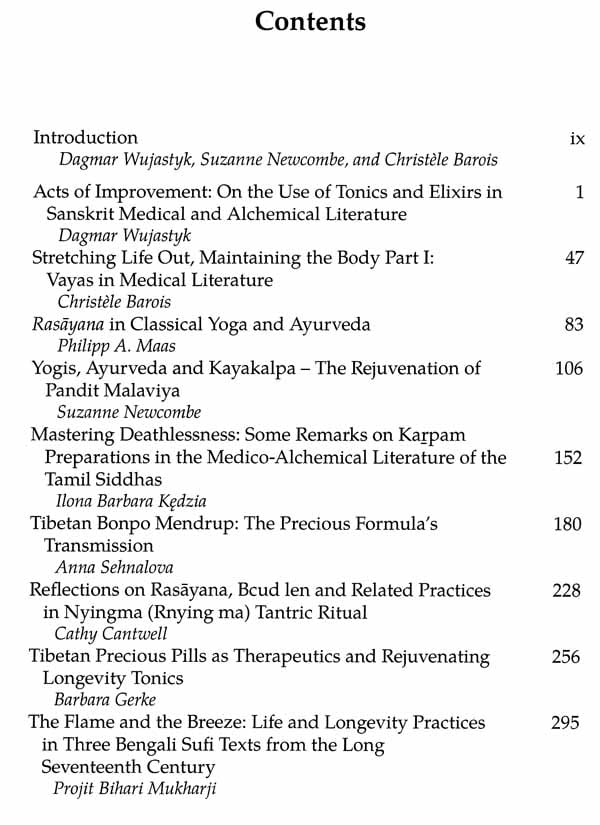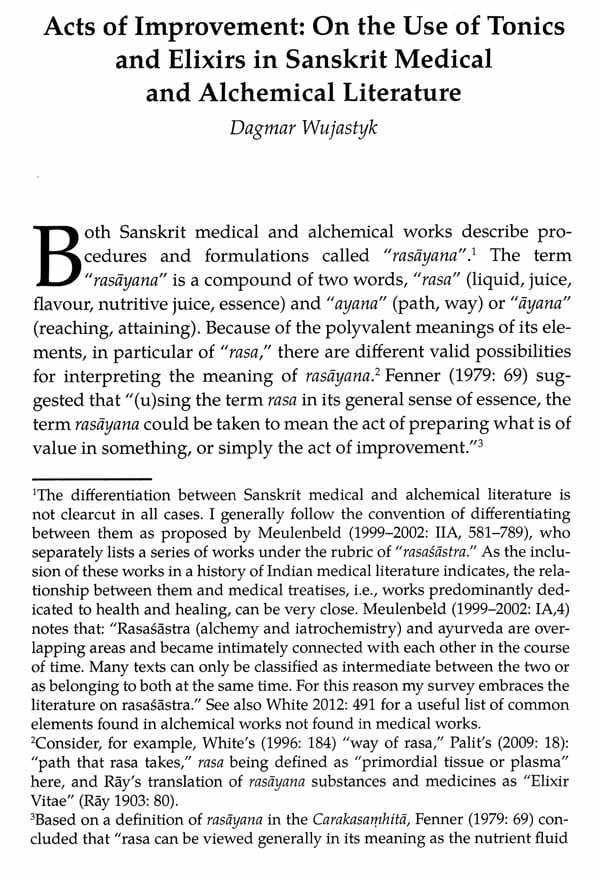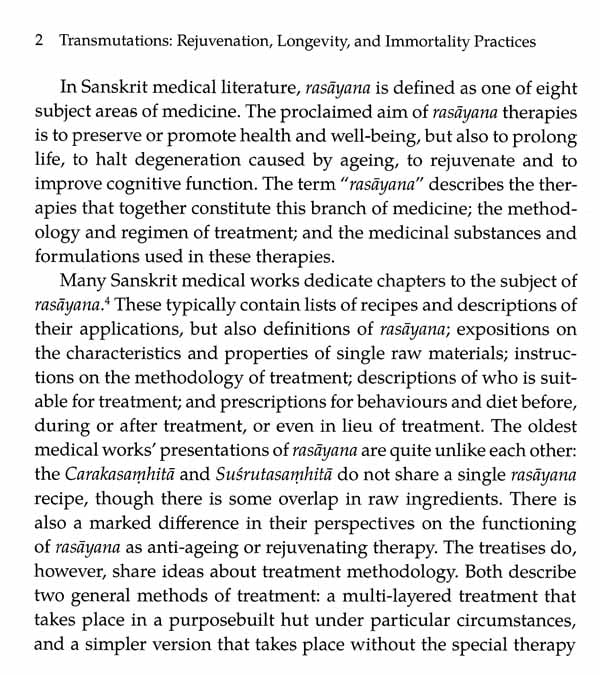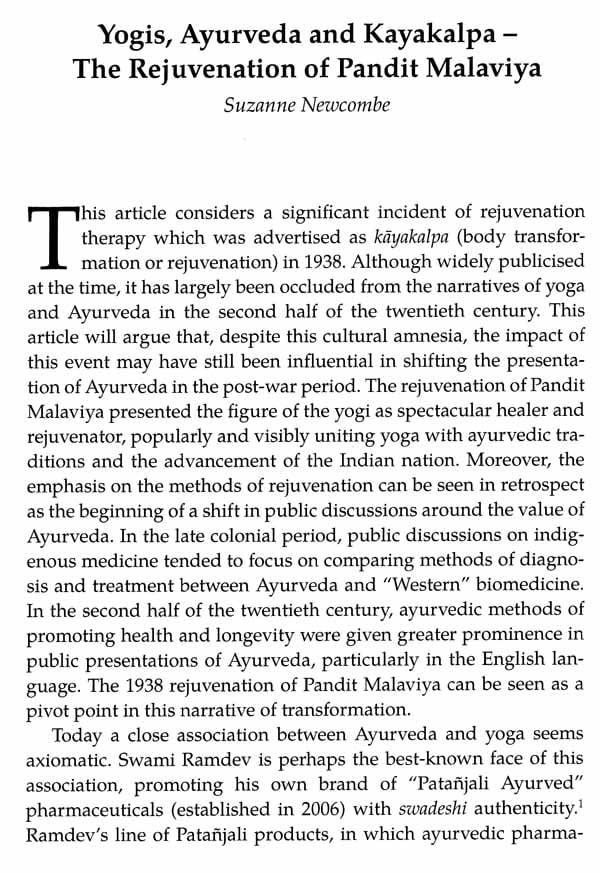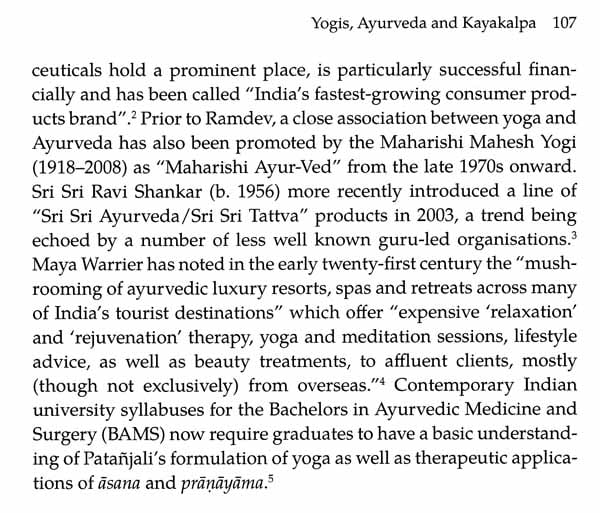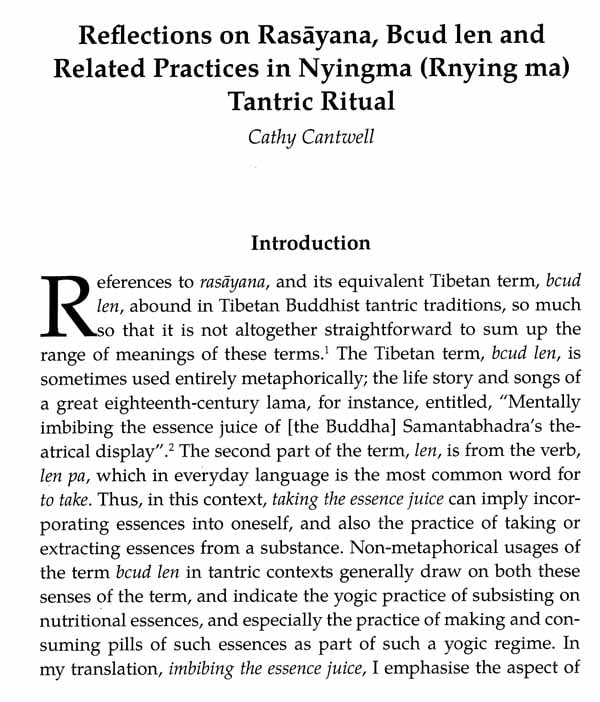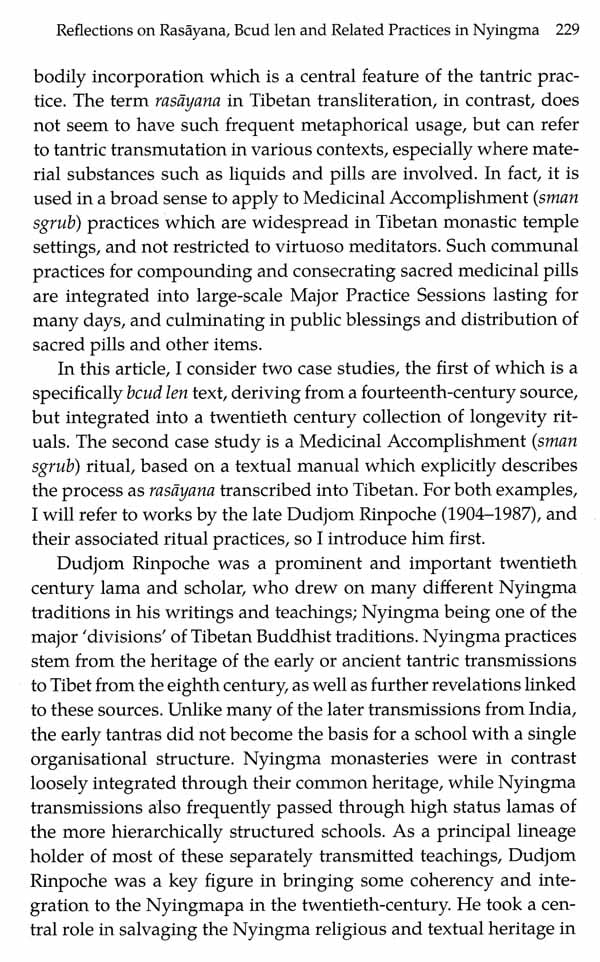
Transmutations- Rejuvenation, Longevity, and Immortality Practices in South and Inner Asia
Book Specification
| Item Code: | NAX699 |
| Author: | Dagmar Wujastyk, Suzanne Newcombe & Christele Barois |
| Publisher: | Dev Publishers and Distributors |
| Language: | English |
| Edition: | 2020 |
| ISBN: | 9789387496408 |
| Pages: | 333 |
| Cover: | HARDCOVER |
| Other Details | 9.50 X 6.00 inch |
| Weight | 690 gm |
Book Description
Wild and diverse outcomes are associated with transmutational practices: the prolongation of life, the recovery of youth, the cure of diseases, invincibility, immortality, enlightenment, liberation from the cycle of rebirths, and unending bliss. This range of outcomes is linked to specific practices taught in separate traditions and lineages in medical, alchemical, yogic and tantric milieus across South and Inner Asia. In this edited volume, transmutational practices and their underlying concepts are examined in the wider context of South and Inner Asian culture. This volume draws together a wide scope of research into this area of enquiry. In addition to the examination of these concepts and practices in Sanskritic South Asian traditions, it features ground-breaking research on the related practices and concepts of kāyakarpam, bcud len and mendrup, developed in the Tamil Siddha medico-alchemical tradition and in Tibetan Buddhist and Bonpo contexts, respectively. The volume also offers an exploration of Islamic yogic longevity practices that emerged in Sufi milieus of the Roshang kingdom between the fifteenth and eighteenth centuries.
Dagmar Wujastyk is Associate Professor at the University of Alberta. She was Principal Investigator of the AyurYog project from 2015-2020, an ERC-funded project investigating the historical links between the South Asian knowledge systems of yoga, ayurveda and rasashastra. Dr Wujastyk's publications include Modern and Global Ayurveda (SUNY Press 2008) and Well-mannered medicine (OUP NY 2012).
Suzanne Newcombe is a Lecturer in Religious Studies at the Open University, UK. She worked as a postdoctoral researcher on the AyurYog project and as Research Fellow at Inform, an independent organisation based at the London School of Economics (2015-2018) and King's College London (2018-2020). She has written Yoga in Britain (Equinox 2019) and is editing with Karen O'Brien-Kop the forthcoming Routledge Handbook of Yoga and Meditation.
Christele Barois is a postdoctoral fellow at the University of Vienna, Austria. She is specialized in ancient and medieval Hinduism through Puranic literature and South Indian SaivaTantras. Her recent work includes a study of the Dharmaputrika, a text belonging to the so-called Sivadharma Corpus that lays out a systematic programme for the practice of yoga.
The journal History of Science in South Asia (HSSA, ISSN 2369-775X) was launched in May 2013 as a vehicle for the Open Access, online publication of peer-reviewed research of the highest international calibre. At the time of writing it has published seven years of superb research into the history of South Asian mathematics, astronomy, medicine and other sciences and has attracted thousands of readers.
In 2017, the journal published its first issue dedicated to a specific theme and edited by guest scholars. Dagmar Wujastyk's Ayuryog project at the University of Vienna (http:/ /ayuryog.org), funded by the European Research Council, had hosted a workshop in 2016 and a conference in 2017 that generated important research on the theme "Transmutations: Rejuvenation, Longevity, and Immortality Practices in South and Inner Asia." These contributions were guest-edited by Dagmar Wujastyk and her colleagues Suzanne Newcombe and Christele Barois and formed the content of issue 5.2 of the journal.
As a result of a fortuitous meeting between myself and Pankaj Jain at the World Sanskrit Conference in 2018, a plan was developed for a collaboration between HSSA and Dev Publishers. I am delighted to present the results of that collaboration in the present volume, in which the HSSA papers are presented for the first time in print for the reading public in India and internationally.
Wild and diverse outcomes are associated with transmutational practices: the prolongation of life, the recovery of youth, the cure of diseases, invincibility, immortality, enlightenment, liberation from the cycle of rebirths, and unending bliss. This range of outcomes is linked to specific practices taught in separate traditions and lineages in medical, alchemical, yogic and tantric milieus across South and Inner Asia. These practices can be individual or collective, esoteric or secular, and occur in different places from hospital to village to monastery; they involve transmutations of substances as well as transmutations of the body. Every expression by a particular lineage has a distinguishing articulation. Yet there are also very clear commonalities and interconnections between the traditions' aims, methods and expected results. In this special issue of HSSA, we examine transmutational practices and their underlying concepts in the wider context of South and Inner Asian culture. How do these practices and ideas connect and crossfertilise? And conversely, how are they delineated and distinct?
This collection of articles was created in the framework of AyurYog, a collaborative project that seeks to unpack how the South Asian milieus of yoga, Ayurveda and alchemy have interacted over time. The quest for youthfulness and longevity is a pervasive theme in Indic literatures, and stories of attempts to prolong life or to become young again are found in many different literary genres. This is a huge and largely understudied area of comparative historical research. The AyurYog project was conceived as a way to open research towards exploring the interconnections between what are typically studied as distinct fields of expertise over a longue duree. As a way of focusing the scope of the research, the AyurYog project has given special attention to longevity and vitalisation practices called rasayana and kayakalpa as possible key areas of exchange between the disciplines of yoga, alchemy and Ayurveda. For the pre-modern period, the AyurYog project has focused on Sanskrit texts, drawing comparatively on works from medical, alchemical and yogic contexts. For the modern period, the AyurYog project is examining how these concepts and practices have changed as portrayed in government reports, print publications, newspaper articles and in contemporary practices where possible. Some of the initial results of the AyurYog project are to be found in this collection of papers.
The transmutational practices represented in Sanskrit sources dialogue with those of other cultures and languages in South and Inner Asia, sometimes including obvious parallels in terms of terminology, procedures or substances used, and at other times demonstrating conscious distinctions between soteriological and technical frameworks. In order to explore some of these dialogues, AyurYog has facilitated one international academic workshop and an international conference. In both scientific meetings, the group of researchers aimed at bringing together the various specialist approaches of similar practices in distinct times and locations in order to arrive at a deeper understanding of the development and positioning of each particular presentation of transmutational beliefs and practices.
In this volume, we are pleased to be able to draw together for publication a wide scope of research into this area of enquiry. In addition to the examination of these concepts and practices in Sanskritic South Asian traditions, we feature ground-breaking research on the related practices and concepts of kayakarpam, chiien (Wylie bcud len) and mendrup (Wylie sman sgrub), developed in the Tamil Siddha medico-alchemical tradition and in Tibetan Buddhist and Bonpo contexts, respectively. The issue also offers an exploration of Islamic yogic longevity practices that emerged in Sufi milieus of the Roshang kingdom between the fifteenth and eighteenth centuries. Many practices first described in centuries-old texts survive into the present in various forms, as the articles here detail.
The article by Christele Barois in this volume takes up the question of how the early Sanskrit medical writers and their commentators conceived of ageing and lifespan in a detailed study of the concept of vayas, a Sanskrit term for "age," "vigour," "youth" or "any period of life." Noting the complexity of the different medical writers' conceptions of vayas, Barois explains how the medical treatises and their commentaries concur in presenting vayas as a general process of transformation that is governed by time, and offers an analysis of what role the different concepts of age and ageing played in medical practice. She questions in particular the meaning of vayahsthapana, "stabilization of age," a positive effect of medical rasayana, in light of the definition of vayas in classical medicine.
Rasayana practices, that is, practices generally associated with the prolongation of lifespan and rejuvenation, are first comprehensively described in the early Sanskrit medical texts, where they are defined as one of eight normative subject areas of Ayurveda. The term "rasayana" itself is difficult to translate, as the two elements of the compound, i.e., "rasa" and "ayana" or "ayana" each have a range of possible meanings. Both Dagmar Wujastyk and Philipp Maas discuss different interpretations of the term in this volume. In Sanskrit medical literature, rasayana describes a type of substance or medicine as well as the regimen and treatment associated with its intake. In most cases, rasayana procedures are depicted in terms of a medical therapy supervised by a physician and administered to a patient, particularly in the context of the more complex treatments. However, the early medical treatises also allude to rasayana as a practice, pro-actively undertaken by individuals wishing for certain results. As shown by Wujastyk, the results of rasayana treatments described in the medical treatises range from anti-ageing effects to the prolongation of life; from the cure of specific diseases to the attainment of perfect health; from the improvement of mental and physical powers to the development of extraordinary powers.
The term "rasayana" is also prominent in Sanskrit alchemical literature, where it is used to describe the characteristics of raw substances and compound formulations, but more often denotes the culmination of alchemical practice. The latter consists of a series of preparatory applications of various cleansing formulations, followed by the intake of mercurial elixirs for transmutation. Here, rasayana describes a regimen in which activities are actively undertaken by practitioners who self-administer elixirs made by themselves in complicated and laborious procedures. As discussed in Wujastyk's article, the alchemical rasayana shares a number of features with the medical rasayana in terms of applied substances, procedures and aims. However, there are also significant divergences. Important concurrences include the methodology of rasayana treatment/practice, which in both literatures is described as entailing the preliminary internal cleansing of the patient's /practitioner's body with predominantly herbal preparations to create optimal conditions for the application of the rasayana tonic or elixir proper.
**Contents and Sample Pages**
